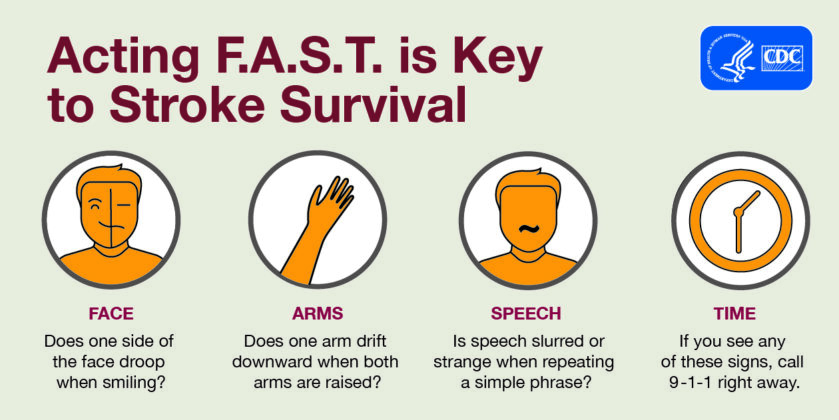Strokes can happen to anyone, at any age. In fact, globally about one in four adults over the age of 25 will have a stroke in their lifetime During American Stroke Month, the American Stroke Association, a division of the American Heart Association, as part of a nationally supported collaboration with HCA Healthcare and the HCA Healthcare Foundation, will teach people everywhere that stroke is largely preventable, treatable and beatable.
A stroke happens when normal blood flow in the brain is interrupted. When parts of the brain don’t get the oxygen-rich blood they need, those affected brain cells die. In cases of stroke, response time matters. Unfortunately, most adults in the U.S. don’t know the F.A.S.T warning signs of a stroke.
Your health is in your hands. Here are 6 ways you can act now to beat stroke:
- Learn how to spot a stroke F.A.S.T. If you see Face drooping, Arm weakness or Speech difficulty, it’s Time to call 911. Learn more at Stroke.org
- Watch the new F.A.S.T. public service announcement featuring celebrities touched by stroke.
- Prevent another stroke – Talk to your doctor about managing risk factors to help prevent a second stroke. Learn more at Stroke.org/StrokeMonth
- Take Control of your BP – Reduce your risk for stroke by knowing your blood pressure and keeping it in a healthy range.
- Raise your voice –Join the American Stroke Association’s You’re The Cure advocacy community at YouretheCure.org.
- Donate funds – Make a gift to defeat stroke at Stroke.org.
“Learning the warning signs and preventative measures are the best way to avoid strokes and keep them from happening again,” said Steven Manoukian, MD, FAHA, senior vice president, HCA Healthcare. “As a leading provider of stroke care, HCA Healthcare and our HCA Healthcare Foundation stand hand and hand with the American Heart Association in our mutually-developed and unique initiative entitled Getting to the Heart of Stroke to educate communities and providers, improve stroke care and prolong and improve the lives of patients.”
Stroke Prevention
A large majority of strokes can be prevented through education and lifestyle changes such as moving more, healthy eating, managing your blood pressure, getting healthy sleep and quitting smoking and vaping. Uncontrolled high blood pressure, diabetes and obesity are major risk factors for stroke. High blood pressure is a leading cause and controllable risk factor for stroke. It’s important to know your numbers and work with a health care professional to manage risks.
People with atrial fibrillation, also called AFib, are up to 5x more likely to have a stroke. AFib is caused by a quivering or irregular heartbeat that can lead to blood clots, stroke, heart failure and other heart-related complications. Most strokes caused by AFib can be prevented with effective treatment, but only about half of AFib patients receive proper therapy.
Additionally, having a stroke puts you at a higher risk for a second one, however, there are things you can do to reduce your risk, starting with identifying what caused your stroke and uncovering all of your personal risk factors.
Stroke Risk Among Diverse Populations
Black Americans have a disproportionately higher prevalence of stroke and the highest death rate from stroke compared to any other racial group. More than two-thirds of Black Americans have at least one risk factor for stroke. Additionally, AFib risk factors are more prevalent among Black people, however, Black patients are less likely to be diagnosed with AFib, which may be related to race/ethnicity. Among other factors, this may be a result of unmanaged risk factors and socioeconomic disparities. Among women, 1 in 5 between the ages of 55 and 75 will have a stroke, with Black women having the highest prevalence of high blood pressure and stroke. The root causes of these disparities are not fully understood. Evidence suggests this is potentially because of exposure to stroke risk factors among Black women at younger ages, as early as childhood. High blood pressure during pregnancy, preeclampsia, gestational diabetes and blood clots during pregnancy all increase a woman’s stroke risk during and immediately following a pregnancy.
F.A.S.T. Experience
The F.A.S.T. Experience is a new digital tool launched by the American Stroke Association this month that engages users in a virtual experience educating them on what the warning signs of a stroke look, feel and/or sound like. By helping users to experience the stroke warning signs in a simulated way that is both educational and engaging, the expectation is that they will retain this information longer and share it with family and friends.
By simulating the symptoms of a stroke – Face drooping, Arm weakness, Speech difficulty, and Time to call 911 – the general public, caregivers, family members, and friends can better understand what stroke patients experience and equip them to spot stroke warning signs and help save a life in the future.
HCA Healthcare Foundation is a national sponsor of the ASA’s Together to End Stroke ® initiative and American Stroke Month.
Additional resources:
- F.A.S.T. PSA (downloadable files)
- AHA news release – Black and Hispanic people in U.S. less likely to get treatment for stroke complications
- AHA News Release – Stroke symptoms, even if they disappear within an hour, need emergency assessment
- AHA news Release – Black women of childbearing age more likely to have high blood pressure, raising pregnancy risks
- Follow AHA/ASA news on Twitter @HeartNews




